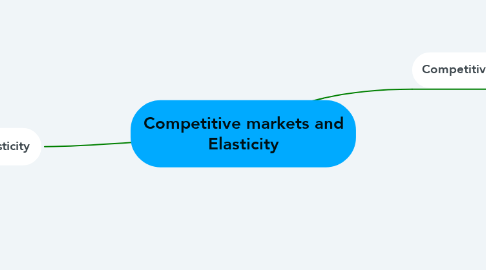
1. Competitive Market
1.1. Market: Arrangement where buyers and sellers can interact for exchange of goods and services for money.
1.1.1. market demand: Summation of all individual demand, this is considered during production.
1.1.1.1. Excess demand is shortage, excess supply is surplus
1.1.1.2. Market Eq is when there is no shortage or surplus
1.1.1.3. Price has two fuctions
1.1.1.3.1. Signaling function: Price change signals to decision makers
1.1.1.3.2. Incentive function: Price change motivates decision makers
1.2. Demand: Quantity of an output that a person is willing and able to buy at a given price over a given period of time
1.2.1. Demand schedule: Shows the relationship between demand and price shown by a demand curve.which shows an inverse relationship meaning as price increases demand decreases.
1.2.1.1. For normal good there is an inverse relationship between price and demand.
1.2.1.2. For snob appeal where consumers are drawn to a product due to its increase in price, the price and demand have an direct relationship
1.2.1.3. Law Of Demand states that there is an inverse relationship between price and quantity demanded
1.2.2. - movement along the demand curve when price changes but demand remains same
1.2.2.1. Law of diminishing Marginal Utility
1.2.2.1.1. Consumer Theory: As the Q of output consumed increases the marginal utility gradually declines so price decreases, that is why D-curve is a downwards slope
1.2.2.1.2. When price rises, rational consumers buy less, so D goes down
1.2.3. -Shift in demand curve when price remains same but demand changes
1.2.3.1. demand curve shifts due to change in weather, trend, fashion, income, due to location, advertisement, govt intervention etc.
1.2.3.2. Shift to the right when there is an increase in quantity demanded, left when there is a decrease in quantity demanded
1.3. Supply:Quantity of a product which a producer offers for sale at a given price over a given period of time.
1.3.1. - Product that can be seen are goods; products that cant be seen/touched are services.
1.3.2. Supply schedule shows the direct relationship between price and Quantity Supplied.
1.3.2.1. Supply can change due to Govt policies, Transportation cost, Cost of storage, cost of alteration, and advancement in technology.
1.3.2.2. Quantity Supplied (QS) changes due to a change in price, and moves along the supply curve. On the other hand, changes in supply causes a shift in the supply curve.
1.3.3. Competitive supply: Between two goods that have the same purpose and thus compete with each other to get sold, Ex, coffee and tea (Substitute)
1.3.4. Joint supply: Production of one product increases the production of another product, Ex, coffee and sugar. (complimentary)
2. Elasticity
2.1. Measure of responsiveness/extent to which demand/supply change due to a change in price
2.1.1. factors influencing elasticity of demand
2.1.1.1. Availability/price of substitute
2.1.1.2. Necessity/ luxury
2.1.1.3. portion of income spent on it
2.1.1.4. if purchase can be delayed
2.1.2. Types of elasticity of demand
2.1.2.1. income elasticity
2.1.2.1.1. YED: measure of responsiveness of a change in demand due to a change in income
2.1.2.2. Price elasticity
2.1.2.2.1. PED: measure of responsiveness of a change in demand due to a change in price
2.1.2.3. Cross elasticity
2.1.2.3.1. XED: measure of responsiveness of a change in demand of one good due to a change in price of another good
2.1.3. PES: measure of responsiveness of a change in supply due to a change in price
2.1.3.1. % change in supply / % change in price
2.1.4. Elasticity
2.1.4.1. Perfectly inelasticity = 0
2.1.4.1.1. change in P causes no change in QD
2.1.4.2. Inelastic 0<elasticity<1
2.1.4.2.1. change in P causes a less than proportionate change in QD
2.1.4.3. Unit elastic = 1
2.1.4.3.1. change in P causes a proportionate change in QD
2.1.4.4. Elastic 1<elasticity< infinity
2.1.4.4.1. change in P causes more than a proportional change in QD
2.1.4.5. Perfectly elastic = infinity
2.1.4.5.1. change in P causes infinite change in QD
2.2. PED
2.2.1. PED
2.2.1.1. +
2.2.1.1.1. Veblen goods
2.2.1.2. -
2.2.1.2.1. Normal goods
2.2.2. YED
2.2.2.1. +
2.2.2.1.1. Normal Goods
2.2.2.2. -
2.2.2.2.1. Inferior Goods
2.2.3. XED
2.2.3.1. +
2.2.3.1.1. Substitute goods
2.2.3.2. -
2.2.3.2.1. Complimentary goods
2.3. PES
2.3.1. +
2.3.1.1. PES is never (-) unless producer is irrational
